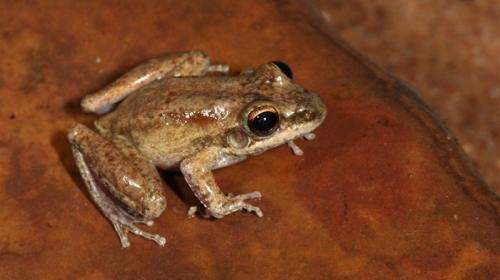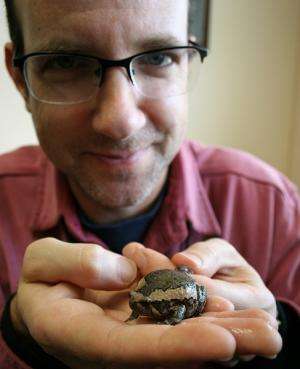Remote Kimberley teeming with unclassified life

A WA Museum herpetologist has described several 'new' Kimberley frog species, mostly collected during field trips with Kings Park botanists Matt and Russell Barrett.
WA Museum's Paul Doughty says much of the Kimberley is not easily accessible so it has a wealth of undescribed species, but they need to schedule collecting trips during the wet season.
"The place is just alive with frogs—for a 'frogger' it's almost sad to go in the dry season because there's just no action," he says.
As the north-west Kimberley has no all-weather roads, they routinely arrive in a helicopter piloted by amateur naturalist Butch Maher.
Dr Doughty says his team found five of the species in the Prince Regent National Park and the Mitchell Plateau area (north-west Kimberley) and one southern Kimberley species near Fitzroy Crossing.
He says the main field equipment is a head torch, a pair of hands and a digital recorder for capturing frog calls.
"Anyone can catch the frogs," he says.
"The hard thing is to get an excellent recording, if it's a male, associated with that frog.
"That can be a bit time consuming and a bit fussy with the microphones and all the cables running through mud."

He says once a frog's call is successfully recorded they capture it for a voucher specimen, and he uses a small portable camera to photograph frogs in the field.
"When we get them back into the lab we'll get some nice photographs with a high-quality mini studio setup, so that people can really see what they're like.
"We take a tissue sample that we can then analyse the genetics for, so we can look at how distinctive these populations are."
They then closely observe the specimens' morphology, asking how they differ from species already described.
New species from the north-west Kimberley are:
- The chattering rock frog Litoria staccato, found near Kununurra and named for its distinctive call.
- The Kimberley rock hole frog Litoria aurifera, which has distinctive gold-flecked tadpoles first collected by Kings Park botanists Matt and Russell Barrett.
- The Kimberley rocket frog Litoria axillaris.
- Crinia fimbriata that doesn't seem to have any close relatives, although the genus occurs across Australia.
- The tiny toadlet Uperoleia micra collected at Mornington Station.
- They also described a little toadlet Uperoleia stridera from the Fitzroy Valley.
Dr Doughty also plays a key role in maintaining the Kimberley field guide, which was last revised in 2009.
Provided by Science Network WA





















